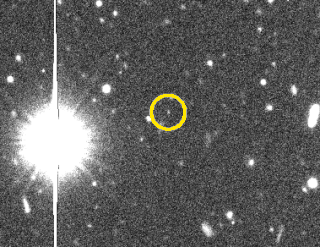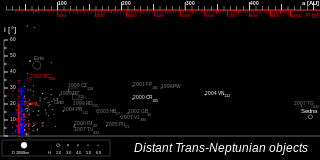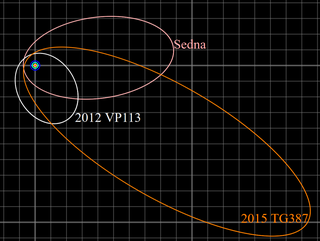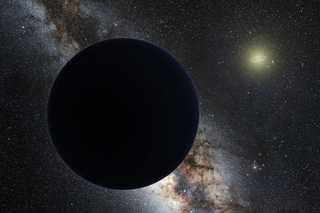Related Research Articles

The nebular hypothesis is the most widely accepted model in the field of cosmogony to explain the formation and evolution of the Solar System. It suggests the Solar System is formed from gas and dust orbiting the Sun which clumped up together to form the planets. The theory was developed by Immanuel Kant and published in his Universal Natural History and Theory of the Heavens (1755) and then modified in 1796 by Pierre Laplace. Originally applied to the Solar System, the process of planetary system formation is now thought to be at work throughout the universe. The widely accepted modern variant of the nebular theory is the solar nebular disk model (SNDM) or solar nebular model. It offered explanations for a variety of properties of the Solar System, including the nearly circular and coplanar orbits of the planets, and their motion in the same direction as the Sun's rotation. Some elements of the original nebular theory are echoed in modern theories of planetary formation, but most elements have been superseded.

Sedna is a dwarf planet in the outermost reaches of the Solar System discovered in 2003. Spectroscopy has revealed that Sedna's surface composition is largely a mixture of water, methane, and nitrogen ices with tholins, similar to those of some other trans-Neptunian objects. Its surface is one of the reddest among Solar System objects. Sedna, within estimated uncertainties, is tied with Ceres as the largest planetoid not known to have a moon. It has a diameter of approximately 1,000 km, with an unknown mass.

Margaret is the only known prograde irregular satellite of the moons of Uranus. It was discovered by Scott S. Sheppard, et al. in 2003 and given the provisional designation S/2003 U 3.

Planetary migration occurs when a planet or other body in orbit around a star interacts with a disk of gas or planetesimals, resulting in the alteration of its orbital parameters, especially its semi-major axis. Planetary migration is the most likely explanation for hot Jupiters. The generally accepted theory of planet formation from a protoplanetary disk predicts that such planets cannot form so close to their stars, as there is insufficient mass at such small radii and the temperature is too high to allow the formation of rocky or icy planetesimals.
In celestial mechanics, the Kozai mechanism is a dynamical phenomenon affecting the orbit of a binary system perturbed by a distant third body under certain conditions. It is also known as the von Zeipel-Kozai-Lidov, Lidov–Kozai mechanism, Kozai–Lidov mechanism, or some combination of Kozai, Lidov–Kozai, Kozai–Lidov or von Zeipel-Kozai-Lidov effect, oscillations, cycles, or resonance. This effect causes the orbit's argument of pericenter to oscillate about a constant value, which in turn leads to a periodic exchange between its eccentricity and inclination. The process occurs on timescales much longer than the orbital periods. It can drive an initially near-circular orbit to arbitrarily high eccentricity, and flip an initially moderately inclined orbit between a prograde and a retrograde motion.
The stability of the Solar System is a subject of much inquiry in astronomy. Though the planets have been stable when historically observed, and will be in the short term, their weak gravitational effects on one another can add up in unpredictable ways.

Detached objects are a dynamical class of minor planets in the outer reaches of the Solar System and belong to the broader family of trans-Neptunian objects (TNOs). These objects have orbits whose points of closest approach to the Sun (perihelion) are sufficiently distant from the gravitational influence of Neptune that they are only moderately affected by Neptune and the other known planets: This makes them appear to be "detached" from the rest of the Solar System, except for their attraction to the Sun.

The Nicemodel is a scenario for the dynamical evolution of the Solar System. It is named for the location of the Côte d'Azur Observatory—where it was initially developed in 2005—in Nice, France. It proposes the migration of the giant planets from an initial compact configuration into their present positions, long after the dissipation of the initial protoplanetary disk. In this way, it differs from earlier models of the Solar System's formation. This planetary migration is used in dynamical simulations of the Solar System to explain historical events including the Late Heavy Bombardment of the inner Solar System, the formation of the Oort cloud, and the existence of populations of small Solar System bodies such as the Kuiper belt, the Neptune and Jupiter trojans, and the numerous resonant trans-Neptunian objects dominated by Neptune.
The five-planet Nice model is a numerical model of the early Solar System that is a revised variation of the Nice model. It begins with five giant planets, the four that exist today plus an additional ice giant between Saturn and Uranus in a chain of mean-motion resonances.
The jumping-Jupiter scenario specifies an evolution of giant-planet migration described by the Nice model, in which an ice giant is scattered inward by Saturn and outward by Jupiter, causing their semi-major axes to jump, quickly separating their orbits. The jumping-Jupiter scenario was proposed by Ramon Brasser, Alessandro Morbidelli, Rodney Gomes, Kleomenis Tsiganis, and Harold Levison after their studies revealed that the smooth divergent migration of Jupiter and Saturn resulted in an inner Solar System significantly different from the current Solar System. During this migration secular resonances swept through the inner Solar System exciting the orbits of the terrestrial planets and the asteroids, leaving the planets' orbits too eccentric, and the asteroid belt with too many high-inclination objects. The jumps in the semi-major axes of Jupiter and Saturn described in the jumping-Jupiter scenario can allow these resonances to quickly cross the inner Solar System without altering orbits excessively, although the terrestrial planets remain sensitive to its passage.
The Nice 2 model is a model of the early evolution of the Solar System. The Nice 2 model resembles the original Nice model in that a late instability of the outer Solar System results in gravitational encounters between planets, the disruption of an outer planetesimal disk, and the migrations of the outer planets to new orbits. However, the Nice 2 model differs in its initial conditions and in the mechanism for triggering the late instability. These changes reflect the analysis of the orbital evolution of the outer Solar System during the gas disk phase and the inclusion of gravitational interactions between planetesimals in the outer disk into the model.

A sednoid is a trans-Neptunian object with a perihelion well beyond the Kuiper cliff at 47.8 AU. Only four objects are known from this population: 90377 Sedna, 2012 VP113, 541132 Leleākūhonua (2015 TG387), and 2021 RR205, but it is suspected that there are many more. All four have perihelia greater than 55 AU. These objects lie outside an apparently nearly empty gap in the Solar System and have no significant interaction with the planets. They are usually grouped with the detached objects. Some astronomers, such as Scott Sheppard, consider the sednoids to be inner Oort cloud objects (OCOs), though the inner Oort cloud, or Hills cloud, was originally predicted to lie beyond 2,000 AU, beyond the aphelia of the four known sednoids.

In planetary astronomy, the grand tack hypothesis proposes that Jupiter formed at a distance of 3.5 AU from the Sun, then migrated inward to 1.5 AU, before reversing course due to capturing Saturn in an orbital resonance, eventually halting near its current orbit at 5.2 AU. The reversal of Jupiter's planetary migration is likened to the path of a sailboat changing directions (tacking) as it travels against the wind.

Pebble accretion is the accumulation of particles, ranging from centimeters up to meters in diameter, into planetesimals in a protoplanetary disk that is enhanced by aerodynamic drag from the gas present in the disk. This drag reduces the relative velocity of pebbles as they pass by larger bodies, preventing some from escaping the body's gravity. These pebbles are then accreted by the body after spiraling or settling toward its surface. This process increases the cross section over which the large bodies can accrete material, accelerating their growth. The rapid growth of the planetesimals via pebble accretion allows for the formation of giant planet cores in the outer Solar System before the dispersal of the gas disk. A reduction in the size of pebbles as they lose water ice after crossing the ice line and a declining density of gas with distance from the sun slow the rates of pebble accretion in the inner Solar System resulting in smaller terrestrial planets, a small mass of Mars and a low mass asteroid belt.

An extreme trans-Neptunian object (ETNO) is a trans-Neptunian object orbiting the Sun well beyond Neptune (30 AU) in the outermost region of the Solar System. An ETNO has a large semi-major axis of at least 150–250 AU. Its orbit is much less affected by the known giant planets than all other known trans-Neptunian objects. They may, however, be influenced by gravitational interactions with a hypothetical Planet Nine, shepherding these objects into similar types of orbits. The known ETNOs exhibit a highly statistically significant asymmetry between the distributions of object pairs with small ascending and descending nodal distances that might be indicative of a response to external perturbations.
In planetary science a streaming instability is a hypothetical mechanism for the formation of planetesimals in which the drag felt by solid particles orbiting in a gas disk leads to their spontaneous concentration into clumps which can gravitationally collapse. Small initial clumps increase the orbital velocity of the gas, slowing radial drift locally, leading to their growth as they are joined by faster drifting isolated particles. Massive filaments form that reach densities sufficient for the gravitational collapse into planetesimals the size of large asteroids, bypassing a number of barriers to the traditional formation mechanisms. The formation of streaming instabilities requires solids that are moderately coupled to the gas and a local solid to gas ratio of one or greater. The growth of solids large enough to become moderately coupled to the gas is more likely outside the ice line and in regions with limited turbulence. An initial concentration of solids with respect to the gas is necessary to suppress turbulence sufficiently to allow the solid to gas ratio to reach greater than one at the mid-plane. A wide variety of mechanisms to selectively remove gas or to concentrate solids have been proposed. In the inner Solar System the formation of streaming instabilities requires a greater initial concentration of solids or the growth of solid beyond the size of chondrules.

Planet Nine is a hypothetical ninth planet in the outer region of the Solar System. Its gravitational effects could explain the peculiar clustering of orbits for a group of extreme trans-Neptunian objects (ETNOs), bodies beyond Neptune that orbit the Sun at distances averaging more than 250 times that of the Earth. These ETNOs tend to make their closest approaches to the Sun in one sector, and their orbits are similarly tilted. These alignments suggest that an undiscovered planet may be shepherding the orbits of the most distant known Solar System objects. Nonetheless, some astronomers question this conclusion and instead assert that the clustering of the ETNOs' orbits is due to observational biases, resulting from the difficulty of discovering and tracking these objects during much of the year.
The Outer Solar System Origins Survey (OSSOS) is an astronomical survey and observing program aimed at discovering and tracking trans-Neptunian objects located in the outermost regions of the Solar System beyond the orbit of Neptune. OSSOS is designed in way that observational biases can be characterized, allowing the numbers and orbits of detected objects to be compared using a survey simulator to the populations predicted in dynamical simulations of the emplacement of trans-Neptunian objects. Conducted at the Canada-France-Hawaii telescope at Mauna Kea Observatories in Hawaii, the survey has discovered 39 numbered objects as of 2018, with potentially hundreds more to follow. The survey's first numbered discovery was the object (496315) 2013 GP136 in 2013.

2015 BP519, nicknamed Caju, is an extreme trans-Neptunian object from the scattered disc on a highly eccentric and inclined orbit in the outermost region of the Solar System. It was first observed on 17 January 2015, by astronomers with the Dark Energy Survey at Cerro Tololo Observatory (W84) in Chile. It has been described as an extended scattered disc object (ESDO), and fits into the group of extreme objects that led to the prediction of Planet Nine, and has the highest orbital inclination of any of these objects.
The hypothetical Planet Nine would modify the orbits of extreme trans-Neptunian objects via a combination of effects. On very long timescales exchanges of angular momentum with Planet Nine cause the perihelia of anti-aligned objects to rise until their precession reverses direction, maintaining their anti-alignment, and later fall, returning them to their original orbits. On shorter timescales mean-motion resonances with Planet Nine provides phase protection, which stabilizes their orbits by slightly altering the objects' semi-major axes, keeping their orbits synchronized with Planet Nine's and preventing close approaches. The inclination of Planet Nine's orbit weakens this protection, resulting in a chaotic variation of semi-major axes as objects hop between resonances. The orbital poles of the objects circle that of the Solar System's Laplace plane, which at large semi-major axes is warped toward the plane of Planet Nine's orbit, causing their poles to be clustered toward one side.
References
- 1 2 Madigan, Ann-Marie; McCourt, Michael (2016). "A new inclination instability reshapes Keplerian discs into cones: application to the outer Solar system". Monthly Notices of the Royal Astronomical Society: Letters. 457 (1): L89–L93. arXiv: 1509.08920 . Bibcode:2016MNRAS.457L..89M. doi:10.1093/mnrasl/slv203.
- ↑ Brown, Michael E. (2017). "Observational bias and the clustering of distant eccentric Kuiper belt objects". The Astronomical Journal. 154 (2): 65. arXiv: 1706.04175 . Bibcode:2017AJ....154...65B. doi: 10.3847/1538-3881/aa79f4 . S2CID 56043830.
- ↑ Fan, Siteng; Batygin, Konstantin (2017). "Simulations of the Solar System's Early Dynamical Evolution with a Self-Gravitating Planetesimal Disk". The Astrophysical Journal. 851 (2): L37. arXiv: 1712.07193 . Bibcode:2017ApJ...851L..37F. doi: 10.3847/2041-8213/aa9f0b . S2CID 55887558.
- ↑ Madigan, Ann-Marie; Zderic, Alexander; McCourt, Michael; Fleisig, Jacob (2018). "On the Dynamics of the Inclination Instability". The Astronomical Journal. 156 (4): 141. arXiv: 1805.03651 . Bibcode:2018AJ....156..141M. doi: 10.3847/1538-3881/aad95c . PMC 6677160 . PMID 31379384.